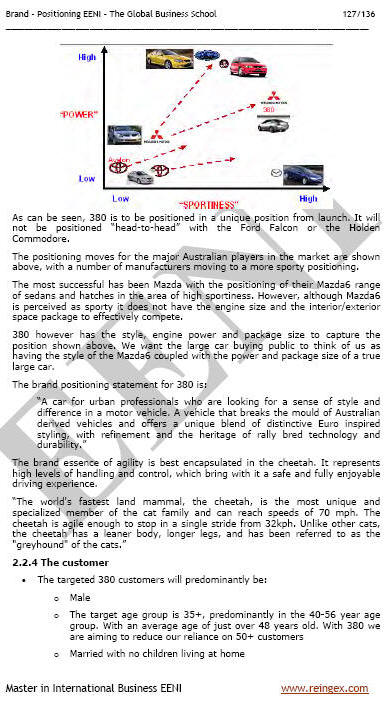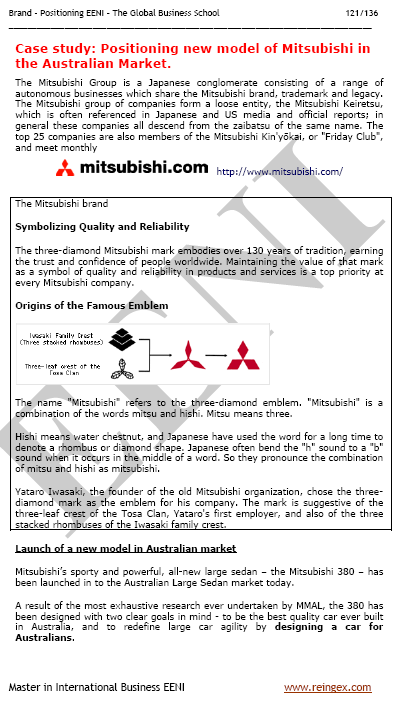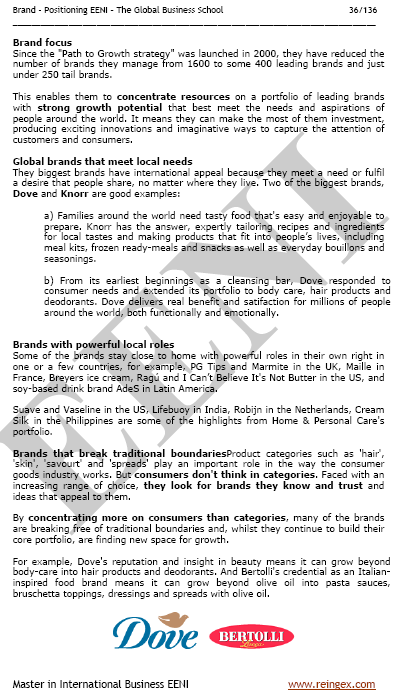Market Segmentation. Brand

International Segmentation, Brand Strategy, and Positioning
The subject “International Segmentation, Brand and Positioning” consists of three parts:
1- International Market Segmentation.
- Importance of the international market segmentation
- Criteria for the market segmentation
- Steps of an international segmentation process
- Niche markets
- Worldwide segmentation strategy
- Targeting strategies:
- Concentrated
- Differentiated
- Product Specialization
- Market Specialization
- Full Market Coverage
- Case Study:
- Segmentation strategy of the Volkswagen Group
- Matsushita Electric (Panasonic)
- United Airlines
- BECEL/FLORA (Unilever)
- VALS reports
2- Global Brand Strategy.
- Brand importance in the strategy of Internationalization
- Brand value
- Brand strategies in the foreign markets
- Global, regional, and local brands
- Building an international brand
- Case Study:
- Top global brands
- Unilever
- Wrigley Company
- ACER
- Gucci Group
- Nutrexpa
- Mitsubishi
- Intellectual Property Rights (TRIPS)
- WIPO
3- International market positioning.
- Introduction to the international market positioning
- International positioning stages
- Strategies of Global Positioning
- Global brand positioning
- The Twenty-two Immutable Laws of Marketing
- Case Study:
- United Biscuits
- Ford Motor Company
- Erste Bank
- Positioning a new product in the Australian Market
The main objective is to learn about the International Market Segmentation, Brand, and Positioning and its importance in the international marketing strategies:
- To understand the importance of the international segmentation in the international marketing and the strategies of Internationalization
- To know the targeting strategies: concentrated, differentiated, product specialization, market specialization, and full market coverage
- To know the main brand international strategies: global, regional, or local
- To understand the process of brand value creation in the global markets
- To know the strategies of positioning a brand in the international markets

The Subject “International Segmentation, Brand and Positioning” belongs to the following Online Programs taught by EENI Global Business School:
Masters: Foreign Trade, International Business.
Diploma: International Marketing.

Course: Advanced Global Marketing.

Languages:  or
or  Segmentation, Marque, Positionnement
Segmentation, Marque, Positionnement  Segmentación, marca, posicionamiento internacional
Segmentación, marca, posicionamiento internacional  Segmentaçao, Marca e Posicionamento.
Segmentaçao, Marca e Posicionamento.
- Credits of the Subject “International Segmentation, Brand and Positioning”: 4 ECTS
- Duration: four weeks
Area of Knowledge: International Marketing.

International Segmentation, Brand, and Positioning
Without a doubt, it would be ideal for an export enterprise to offer a tailored (or adapted) product or service to each of its clients (importers). As this is impossible, the exporter need to develop goods and/or services tailored to the different market segments.
International market segmentation is a key element of the International Marketing Plan. The global market segmentation will require a strong effort to focus the strategy in each market niche.
The main objective of the international segmentation is to improve the brand position of the product or service.
Sample - International Segmentation, Brand and Positioning:

The International market segmentation allows the exporter:
- Product or service differentiation
- To manage local, regional, or international distribution
- To improve the communication and promotion policy for each segment
International Targeting Strategies:
- Concentrated strategy
- Differentiated strategy
- Product specialization
- Market specialization
- Full market coverage
Positioning is the process of designing an offer and enterprise image so that it occupies a distinct and valued place in the mind of the consumer.
The objective of positioning a product or a service is to make sure that it occupies a certain place in the mind of the consumer (importer), differentiating it from the competition.
Positioning a product or service consists gaining a proper meaning in the mind of the customer as to where the product or service sits in the market segment to which it belongs.
This may be achieved by the product attributes (or service) or through the international promotion policy.


(c) EENI Global Business School (1995-2024)
We do not use cookies
Top of this page



